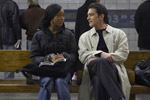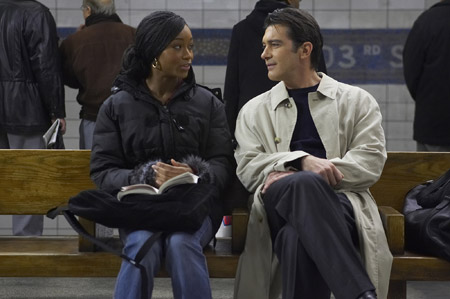Take the Lead
 Let it be said that Antonio Banderas can take even an aggressively formulaic movie and turn it into a passable affair—sort of. In this case, he plays dance instructor Pierre Dulaine. From pierredulaine.com, I learn that the real Dulaine studied dance from the age of fourteen in England and by 21 became a member of the Imperial Society of Teachers of Dancing, won several international championships, and moved to New York in…
Let it be said that Antonio Banderas can take even an aggressively formulaic movie and turn it into a passable affair—sort of. In this case, he plays dance instructor Pierre Dulaine. From pierredulaine.com, I learn that the real Dulaine studied dance from the age of fourteen in England and by 21 became a member of the Imperial Society of Teachers of Dancing, won several international championships, and moved to New York in…

in New Line Cinema’s TAKE THE LEAD.
Photo: ©2005 Kerry Hayes/New Line Productions
Let it be said that Antonio Banderas can take even an aggressively formulaic movie and turn it into a passable affair—sort of. In this case, he plays dance instructor Pierre Dulaine. From pierredulaine.com, I learn that the real Dulaine studied dance from the age of fourteen in England and by 21 became a member of the Imperial Society of Teachers of Dancing, won several international championships, and moved to New York in 1971 where later he began a student outreach program that is the subject of this film.
The film begins with contrasting views of Dulaine’s world and the world of the inner city students he’s going to teach. He’s attending an Annual Winter Gala, and elsewhere young boys and girls grind to hip hop beats at a school dance. A young man, Rock (Rob Brown), is kicked out of the dance and winds up being coerced by his friends to vandalize the principal’s car. And this is where the stage sets for the routine melodrama.
Rock dutifully serves the role of the Troubled Black Teen Who Means Well, with the deadbeat mother and drunk of a father. Therefore, we’re intended to feel sympathetic for him even though the stupid decisions he makes are entirely his and entirely avoidable, given his otherwise demonstrable intelligence. Dulaine witnesses the vandalizing, and the next day visits the school to notify the principal, Augustine James (Alfre Woodard). However, instead of informing on Rock’s crime, Dulaine has a proposition: He wants to teach the school’s delinquents ballroom dance in the hopes that they might learn to channel their passions in a disciplined manner.
James starts out as the Spiteful and Arrogant Principal With Too Much On Her Plate (and pictures of the victims of the mandatory inner city school violence on her wall, to undoubtedly reinforce the idea that, gosh darnit, she really does lay awake at night worrying about her schoolkids), but becomes the Unexpected Ally when Dulaine is confronted by another teacher who presents the same argument James used at the beginning of the film: There are kids with greater needs and more initiative so why teach these kids a discipline like dance when they need to learn less applied principles that are even harder to connect to any practical situation—even if by creative analogy.
The long and short of it you already know. Dulaine sees potential in these kids that the present administration does not, and he challenges the kids to find out what they’re capable of. It’s a ridiculous and almost racist proposition because it’s never a school of downtrodden white kids in Omaha where these stories take place. We always need a proper distribution of Hispanics who mack too much, black kids whose only other “chance to make it out of the ghetto” are (or so the stereotype goes) basketball or criminal activity, and at least one gorpy white kid who dresses and speaks in a manner such that, we’re encouraged to believe, only black kids should.
Again, it fails the audience when a film requires the “way out” to be punctuated in some form by a contest in which the students must prove themselves. In such cases, they are almost never proving it to themselves for their own sake, there’s always a nemesis. Enter Evil White Affluent Kids, whose senior representative is Morgan (Katya Virshilas), the über-competitive Neo-Nazi poster child (tall, blonde, moves like “sex on hardwood” says one student).
In the course of trying to get the kids inspired, Dulaine predictably invites Morgan to come down to the school and show the kids a thing or two. This provides of course about ten seconds of theatrical trailer fodder (Just when you thought they were disinterested… HOT CHICK shows them the TANGO! GASP! Watch the guys all atwitter with hormones and the girls venomously jealous reactions!) and zilch in the way of character development, except to say that Morgan’s personality takes an abrupt and absurdly irrational turn by the very end of the film.
The film relies heavily on the skill of Banderas as an actor and his persuasiveness on screen. He has that charisma that makes you believe in the passionate attitude of the character he plays, or maybe it’s just the way he works his accent and elocution. But if you were to stop and think about everything else about the characters, the story and how it goes through it’s checklist, epitomized in 80’s inspirational student-triumphs-over-socioeconomic-pseudoreality films like “Lean on Me” and its lesser-known predecessor “Stand and Deliver”, then you come to the realization you’re not being told anything that hasn’t been conveyed at least a thousand times before on film, and in print, only in more interesting ways and means.
In fact, there’s a moment where the abrasive relationship between LaRhette (Yaya DaCosta) and Rock, who share common tragedies, is compared by Dulaine, indirectly, to Shakespeare’s Romeo and Juliet. The film isn’t a strict adaptation of the Bard’s classic tragedy, but you can see how the plotline seems more inspired by it than, necessarily, the “true story” of Dulaine and his Dancing Classroom outreach program.
The dancing is impressive in places, but the lesson is ultimately no less shallow than in movies that follow the Hollywood safe-bet of glorifying basketball as the “only way out” for all black youth: Compete and win money. Though Dulaine makes an interesting parallel before a parent-teacher committee regarding the disciplinary habits that can be encouraged by learning ballroom dancing, there is otherwise little emphasis placed on the intellectual and cultural gain from learning this art. It’s mostly about the final competition and the self-gratification of proving the lowly inner-city schoolchildren are as good as, if not better than, the uppity academy types.
There are a few manufactured crises that are ripped right out of the recipe book, including a patently absurd choice Rock has to make between a life of crime and, well, going to that final ballroom dancing competition. As if, when presented with such diametrically opposite choices, any one person would find it hard to pick one over the other. Anyone even remotely considering helping out a fencing racket doesn’t strike me as the kind of person who would be much embattled about passing on the ballroom competition, and vice-versa.
The only reason “Take the Lead” just barely works depends on how much you appreciate Banderas’ and Woodard’s acting, and, to a lesser extent, how much tolerance you have for seeing the same recycled hardscrabble-kids-against-the-odds story yet again. You might enjoy it mildly while watching it, and then wonder where two solid hours of your life went in a story that doesn’t require more than ten minutes to get re-acquainted with. I might get as far as telling you, “So the teacher walks into the rowdy classroom and nobody listens when he introduces himself and his lesson plan,” before you nod off.
 Take the Lead • Dolby® Digital surround sound in select theatres • Running Time: 108 minutes • MPAA Rating: PG-13 for thematic material, language and some violence. • Distributed by New Line Cinema
Take the Lead • Dolby® Digital surround sound in select theatres • Running Time: 108 minutes • MPAA Rating: PG-13 for thematic material, language and some violence. • Distributed by New Line Cinema